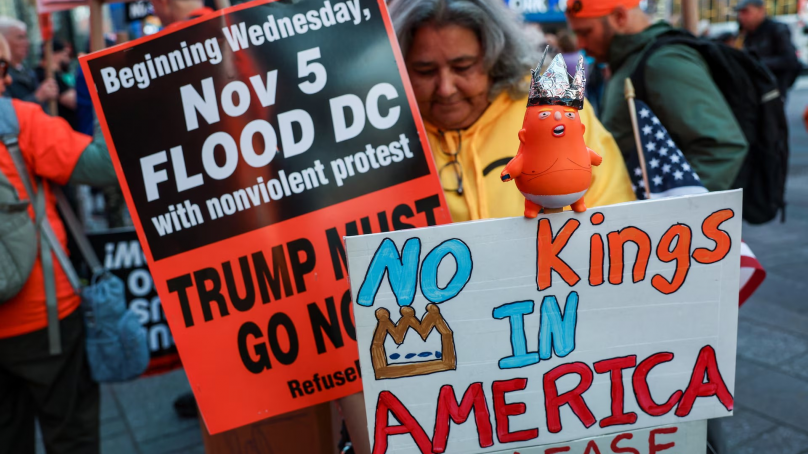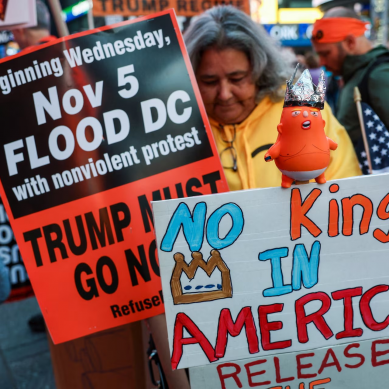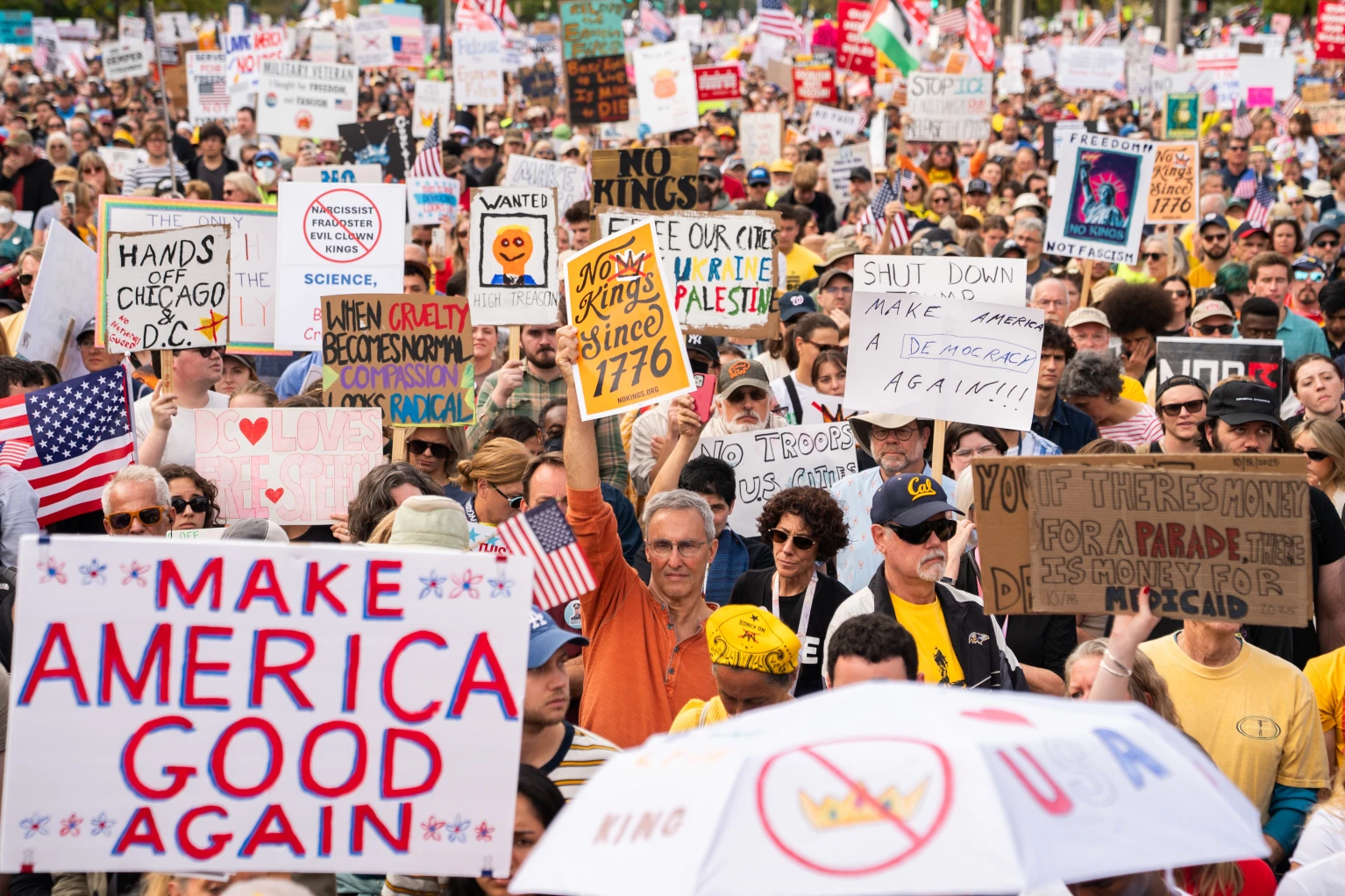
The Trump administration has made it clear that it fears mass, nonviolent protests more than anything else.
Last Friday, new talking points were seemingly rolled out across the MAGA sphere. Top GOP leadership, from House Speaker Mike Johnson to Minnesota Representative Tom Emmer to Transportation Secretary Sean Duffy, began seeding a narrative about today’s “No Kings” protests.
Rather than describing them for what they are – First Amendment-protected rallies where millions of Americans are expected to peacefully stand against the Trump administration’s unconstitutional, authoritarian and un-American agenda – Republican leadership is framing the upcoming demonstrations as “Hate America” protests. Party leaders also called the gatherings “terrorist” and “Soros-funded” events that would be filled to the brim with “the antifa crowd, the pro-Hamas crowd and the Marxists.”
This trial-balloon messaging is meant to get ahead of what organisers say could be one of the largest days of mass protest in US history, with events planned in every state. Millions of Americans are projected to attend some 2,500 rallies to oppose the illegality and immorality of the Trump agenda, the destruction of hard-won civil and constitutional rights, and the fascist ambitions of the MAGA movement.
Republican leaders are attempting to pre-emptively cast this protest within the framework Stephen Miller has been working to aggressively mainstream since the assassination of Charlie Kirk, where all who oppose the extremist MAGA agenda are “domestic terrorists.”
To their credit, Democratic and Independent leaders responded quickly. Senator Bernie Sanders issued a statement pointing out that the No Kings protests are protected under the First Amendment and, contrary to right-wing smears, protesters are standing up for American values. Former Republican and now Independent Joe Walsh called out the GOP’s attempt to vilify half of the American electorate as “shameful” in a post on Twitter and urged his followers to attend the protests, emphasising that his former party is “scared to death” of the looming rallies.
It’s true: MAGA is terrified of the spectre of massive nonviolent protest – and for good reason. Nothing threatens their agenda more than millions of ordinary Americans mobilising to put a face to the opposition.
The administration has been working overtime in recent weeks to vilify and alienate its opposition, painting Democrats and left-leaning activists alike as violent extremists. With their media footholds and tight messaging discipline, they’ve had some success in painting a picture of a fictional, widespread antifa threat, which is already serving as a pretext for the Trump’s administration’s Justice Department to file terrorism charges against its foes.
But pictures are louder than words or soundbites. Even small-scale protests, like the inflatable frog demonstrations against ICE in Oregon, have resonated widely and effectively negated MAGA’s breathless portrayal of Portland as a city under siege by any forces other than the National Guard.
By making visible both the magnitude of opposition to MAGA’s authoritarianism and the everyday relatability of the Americans who are taking a righteous stand, the No Kings rallies pose a real PR problem for the extremist right. They puncture the narrative fictions that the MAGA movement has been working so hard to construct and undermine the credibility of their messengers. They also force GOP leaders into the awkward position of explaining why a large swath of the American public, from every walk of life are, supposedly “domestic terrorists.”
Mass nonviolent protests also effectively jolt the disengaged public to pay attention. Americans understandably tune out of day-to-day politics to focus on their immediate sphere; they’re overwhelmed, exhausted, and cynical about politics. But moments of mass protests, when millions are in the streets, are hard to ignore. They generate news coverage and powerful images that serve as irrefutable proof that all is not well, and there is widespread opposition to the regime’s agenda. Critically, they also remind us that we’re not standing alone.
Protests as evidence of widespread defiance also reach far beyond the American public. They resonate with international audiences and key decision-makers in places like the Supreme Court, the military and other institutions that may soon be in a position to decide if they will further comply with the administration’s demands.
Political scientists Erica Chenoweth and Maria Stephan’s widespread research on the power of nonviolent protest spells out how protest and institutional compliance impact one another. In their findings, they identify that once 3.5 per cent of a country’s population is engaged in sustained nonviolent protest, authoritarian regimes find it difficult, if not impossible, to carry out their agendas. That’s because visible protest from large swaths of the population signals a deeper opposition throughout society, including within the very institutions and constituencies an authoritarian regime needs to enforce its will. Widespread public resistance makes obedience – and the carrying out of unconstitutional orders – exponentially harder.
And even for those sitting on the fence, mass protest is among the most powerful tools of persuasion available. The Trump administration remains deeply unpopular and the No Kings protests have the potential to push that unpopularity to new heights.
Throughout US history, mass protest has driven some of our most consequential shifts in public opinion. Mass protests were critical in building public support and shaping beliefs to win core democratic advances, including civil rights, the social safety net, and women’s suffrage.
Sociologist Charles Tilly distilled the key qualities that make mass protest persuasive, popular and durable. His framework offers four key elements for a successful movement: worthiness, which hinges on the credibility of the participants; unity, which refers to the cohesiveness of the messages; numbers, or the size of the protest; and commitment, or ability of those involved to persevere.
Scholars later added a fifth – diversity – to assess the breadth of who is represented. Together, these elements correlate strongly with a movement’s legitimacy, its ability to inspire bystanders to join in and its power to influence elites and institutions.
The last time this full constellation appeared in the United States was during the overwhelmingly peaceful George Floyd protests. It may be hard to remember in this moment of revisionist backlash, but that massive, multiracial, and persistent protest moment powerfully shifted the national conversation on systemic racism. In the summer of 2020, nearly 1 in 5 Americans named race relations as the country’s top concern and a majority recognised systemic racism as a societal problem. That surge in public consciousness and moral urgency around ending systemic racism was so persuasive and enduring that it drove Democratic voter registration and helped propel Joe Biden to victory in the 2020 election.
Through this framework, we can clearly understand the threat the MAGA regime sees in the No Kings protests: Millions (numbers) of everyday Americans (worthiness) from all walks of life (diversity) standing together (unity) for the second time (commitment) for core American values and constitutional and civil rights pose an existential threat to authoritarian ambitions. It is a potential turning point – one that could accelerate the erosion of support for MAGA’s political project, grow the pro-democracy movement that opposes it, and sow seeds of doubt within the administration’s ranks.
Around the world, authoritarians are wising up. In their research, Chenoweth notes that globally nonviolent movements are meeting less success than in decades past, as regimes coordinate with each other and devise new strategies to curtail their impact, such as controlling the flow of information and working to outright criminalise protest. It’s happening in the US, too: The Trump administration is keenly aware of the potential for mass nonviolent protest to shape public sentiment, which is why it is moving quickly to undermine and dismantle all infrastructure for opposition and organized dissent.
The primary MAGA crony behind this effort is White House deputy chief of staff Stephen Miller. Miller has made abundantly clear that he intends to dismantle his political opposition by forcing the narrative that any opposition to his agenda should be tamped down using the full power of the state. He recently seized his opportunity to create a new designation of domestic terrorism to justify the investigation, dismantling, and defunding of oppositional civil society.
The administration is moving forward with plans to weaponise the IRS and so it can be used to launch criminal probes into left-leaning philanthropic and civil society organisations. Trump acolyte Senator Ted Cruz has introduced legislation that will make it easier to charge organisations that fund or support public mobilisation with RICO charges and just this week he invoked No Kings as one reason to pass the bill.
The administration hasn’t been shy about the groups it wants to target first. Trump himself has said he wants to go after his enemies on the left. A shoddy report from the conservative non-profit Capital Research Centre, which is believed to be a guiding document for the administration crackdown, cites mass-mobilising groups like Indivisible, Jewish Voice for Peace and the youth-led Sunrise Movement as “inciting terrorism.” It’s no accident that among MAGA’s first targets are organisations that have the strongest track records of non-violently mobilising the American public at scale and facilitating media-friendly protests that can move public opinion.
Getting rid of organisations that empower Americans to participate in legible nonviolent mobilisation is a great way of ensuring that the conceptions of the opposition that reach the public are those that feed the MAGA narrative of a deranged left.
That is why mass public opposition is so vital now, before this crackdown fully takes hold. This is a crossroads moment for our country, and the media should give these protests the coverage and consideration they deserve.
When the attacks against the civic sector organisations that support and anchor mobilisation do come, they must be called out for what they are: as nothing less than efforts to stifle free expression, crush the First Amendment and silence dissent.
Because even if “No Kings” isn’t exactly how you might describe the problem we are facing, or you don’t want to hang out with #Resist wine moms or you don’t think it would be as impactful as a general strike, there is no easier or more important thing that you can do today for the well-being of this country. These protests could be a tipping point to halt the Supreme Court’s complicity with the MAGA agenda, or be the deciding factor in stopping the military from responding to protesters with outright violence (a possibility Trump has reportedly mused about).
We don’t know exactly how the ripples from this protest will compound but we know that visible opposition is critical. So if you’re concerned about what’s happening in this country, go to a No Kings protest. Then go to the next one, too.
- A Tell Media report







